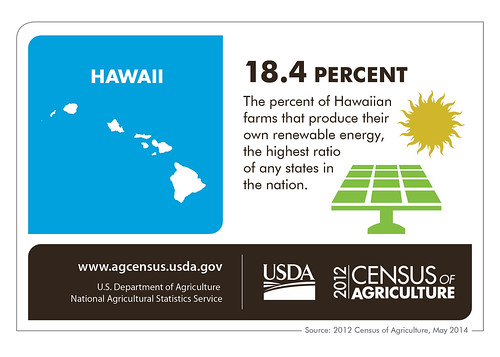
The Census of Agriculture is the most complete account of U.S. farms and ranches and the people who operate them. Every Thursday USDA’s National Agricultural Statistics Service will highlight new Census data and the power of the information to shape the future of American agriculture.
Hawaii may have only 7,000 farms, but our farming community is truly special and unique. For example, it is the only state in the United States where farmers grow taro, pineapples for commercial sales, and coffee. And if having such unique commodities isn’t enough, it is also the state that has the largest percentage of farmers and ranchers participating in renewable energy projects, according to the 2012 Census of Agriculture. More than 18 percent of our farms produce their own renewable energy on their farms.
The island environment is conducive to renewable energy production. Hawaii has abundant sunshine and steady trade winds which are favorable for investing in renewable energy systems. As a result many farms can set up photovoltaic panels and windmills to convert the sun and the wind to electricity.
Hawaii also has a unique economic structure. Hawaii's kilowatt electricity rate is three times what is charged on the mainland United States. The state also does not have an inter-island electrical grid system as much of the electricity is generated using low sulfur oil from Indonesia. These factors provide extra incentive for Hawaii agricultural producers to invest in renewable energy especially wind and solar as all producers are pressured by slim profit margins and high operating costs.
Our volcanoes also help Hawaiian farmers. Operators take advantage of geothermal energy drawn from active volcanos on the Big Island where the majority of the State's farms and ranches operate. This favorable ecological option is preferred due to Hawaii's fragile environment along with being the most isolated population center in the world.
And to top it all off, the Aloha state also is a veritable melting pot, boasting one of the most diverse farmer communities. Hawaii has the largest percentage of racial and ethnic minority farmers of any state. Asian and Pacific Islander farmers make up more than half of all farmers in our state, which is higher than the ratio of these farmers in any other state.
As you can see, unique is the key word when it comes to Hawaiian agriculture. But don’t take my word for it. Feel free to visit our state and explore our unique agriculture. We welcome all visitors. Aloha!
